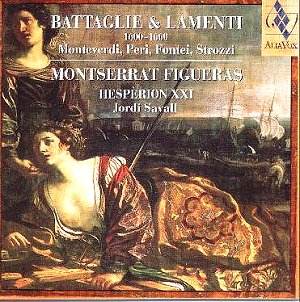Battaglie & Lamenti: 17th Century music for battles and
lamentation
Samuel SCHEIDT
(1587-1654)
Pavan (1621)
Galliard Battaglia (1621)
Claudio MONTEVERDI
((1567-1643)
Lamento d'Arianna: Lasciatemi morire
(1608)
Giovanni GABRIELI (ca.
1554-1612)
Canzon III a 6. (1621)
Bastiano CHILESE (fl.
1608)
Canzon in Echo a 8 (1608)
Jacopo PERI (1561-1633)
Lamento di Iole (1628)
Luigi ROSSI (1598-1653)
Fantasia "Les Pleurs d'Orphée2
(1630)
Nicolò FONTEI (ca. 1600-ca.
1647)
Pianto d'Erinna
(1639)
ANONYME
Sarabande Italienne, (ca. 1650)
Barbara STROZZI (1619-1664)
Il Lamento "Su'l Rodano severo"
(1634)
Andrea FALCONIERO (ca.
1585-1656)
Battaglia de Barabasso yerno de Satanas
(1650)
 Montserrat Figueras
(soprano)
Montserrat Figueras
(soprano)
Ton Koopman (clavecin); Rolf Lislevand (théorbe); Robert Clancy
(théorbe)
Jordi Savall (basse de viol); Paolo Pandolfo (basse de viol);
Lorenz Duftschmid (violone)
Hespèrion XXI/Jordi
Savall
 ALIAVOX AV 9815
[76:12]
ALIAVOX AV 9815
[76:12]
Crotchet
AmazonUK
AmazonUS

Battaglia and lamento are two genres that cover the whole range
of musical expression in both the vocal and instrumental music of the
17th century. Battaglia covers the din of battle, soldiers
spurred by the rhythm of drums and the sound of trumpets while the lamento
covers the personal anguish of individuals or whole nations trapped in
a hopeless situation. The origins of the battaglia can be traced to
the beginning of the 16th century; the earliest lamenti
were composed before the end of the 16th and the beginning of
the 17th centuries. In fact it was in 1528 that Clément
Janequin's chanson La guerre that set the model for future musical
battaglie. The works in this collection are a fine representative
selection of both genres.
I have often praised Jordi Savall's direction of Renaissance and Early Baroque
music. His earlier recordings for Alia Vox have been remarkable for their
scholarship, lucidity and vitality. This latest album is no exception. The
numbers associated with battles are colourful and lively. The programme commences
with the Pavan and Galliard Battaglia of Samuel Scheidt. Rather
appropriately, the Pavan gives the impression of a mix of lamentation and
celebration; there is the formality of strict drumbeats both in a doleful
funeral procession mode, and in the urge to battle; and there is music in
a more celebratory mood. In fact, one might imagine this music as dance music
too, like the material in some parts of the Galliard when war-like bugles
are not sounding. (After all, in musical dictionaries, Galliard is defined
as a "lively dance from 15th century or earlier in simple triple
time"). Additionally, we have the lively and celebratory Canzon's of Giovanni
Gabrielli and Bastiano Chilese which must have sounded magnificent in the
acoustic possibilities offered by, for instance, St Mark's cathedral, Venice
- particularly Chilese's Canzon in Echo with its near and distant
canonic echoes adding so much more interest. Guami's Canzon sopra la
Battaglia is somewhat relaxed, the fray somewhat gentlemanly and elegant,
one imagines. Not so the final number, Andrea Falconiero's energetic
Battaglia de Barabasso yerno de Satanas. This is exciting indeed and
must have spurred the troops with its biting pizzicatos and thrilling overlapping
brass imperatives.
There are two other purely instrumental numbers: Luigi Rossi's beautifully
mournful Fantasia "Les Pleurs d'Orphée" and the dainty dance rhythms
of the Anonymous Sarabande Italienne.
The most extended numbers in the programme are the laments, sung very
expressively and with great passion by Montserrat Figueras (most beautifully
accompanied, especially by Ton Koopman). Ms. Figueras's dark-hued and smoky
voice is ideal for such material where most of the lines lie in the soprano's
lower registers and she loses no opportunity to express the wide range of
emotions expressed by her hapless heroines: grief, anger, hurt pride, impatience,
spite and yearning. She begins expressing Arianna's (Ariadne) grief at being
abandoned on a desert island by Theseus before Bacchus will deliver her,
in Claudio Monteverdi's Lamento d'Arianna, the work which really founded
the musical genre of the lamento. It is a highly expressive recitative of
such emotional intensity that it reduced the audience to tears. Arianna's
lament mounts to an almost hysterical frenzy as she invokes all the terrors
of the seas, sharks, whales and storms to avenge her before she droops down
again in resignation. Jacopo Peri's Lamento di Iole is very much in
the same mould, except that this time it is Iole grieving for Hercules abandoning
her for the glory of the wars, leaving her to gnash her teeth and agonise
imagining her hero disporting in the arms of others. The lament was also
used in a more universal capacity to deplore certain political events like
the fall of Constantinople, the death of a sovereign, the defeat of a general,
or oppression by some foreign power. Unusual in two ways, is Barbara Strozzi's
lurid and melodramatic Il Lamento, "Su'l Rodano severo" because, of
course, it is written by a woman (in an age when so few women were heard)
and secondly its theme is not thwarted romance but political tragedy. The
singer mourns the downfall and death of Henri Cinq-Mars, the favourite of
King Louis XIII, who was first protected then cast aside by Cardinal de
Richelieu.
The packaging and presentation is first class. Another feather in the cap
for Jordi Savall and his players.
Ian Lace

